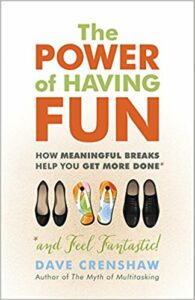How Meaningful Breaks Can Help You Get More Done
Fun should be a top priority.
It shouldn’t be relegated to the bottom drawer, the one you open only when all the real work is done.
It’s not a distraction or a diversion.
That’s what Dave Crenshaw teaches in his new book, The Power of Having Fun: How Meaningful Breaks Help You Get More Done (and Feel Fantastic!). Dave is the founder of Invaluable, Inc., a coaching and training organization that helps transform businesses.
Dave recently spoke with me about his mission to have more fun in your life and, yes, even at work.
We Have Fun All Wrong
Fun isn’t something many executives talk about, but its benefits are important to individuals and to organizational culture. Why do we have fun all wrong?
The first issue is the emphasis on “fun” rather than “having fun.” The distinction is important because I view fun as an action. It’s something that we must make a part of our daily schedule. While others put emphasis on humor and culture, I put emphasis on planning and follow-through.
It’s the action of having fun―taking a break and doing something meaningful and enjoyable―that makes the real difference. Then we move beyond concept and theory and into implementation. The real “power” of having fun is in the doing of it!
The second issue is one of the biggest mistakes nearly every business leader makes. Leaders are tempted to think that everyone else will like to do what they like to do. For instance, the CEO may decide to hold a company bowling day…which is great—for the 40% of people in their company who love bowling.
Instead, leaders should become facilitators of unstructured, self-directed fun. For example. LinkedIn has one day each month for employees to recharge their batteries. While these “InDays” have a monthly theme, there’s a ton of latitude for employees to select activities for themselves.
Do you see perceptions of fun changing with the Millennial generation?
I see the major differences being less of a generational issue and more of a life-situational issue. For example, I put a lot of emphasis in the book on creating “Family” Oases. I then define family very broadly, to include your traditional family―if you’re close to them―as well as best friends, parents, siblings, boyfriends/girlfriends, the grandparents you never forget to visit on weekends, your party-animal roommates, and even your trusted dog Sparky.
Those who are unmarried and without children are more likely to define these Family Oases in terms of time spent with friends and even co-workers. At the moment, most millennials find themselves in this life-situation. However, once they transition into marriage and children, their priorities―and their definitions of “family fun”―begin to change as well.
The good news is, no matter your life situation, you and your loved ones can still receive the same benefit from carefully choosing, planning, and enjoying having fun together.
Recognize Your Desert
Recognizing your desert (your personal challenge) isn’t always easy. You outline different ways executives get trapped. Would you describe one or two?
A desert is how I’ll refer to an extended period of deprivation and/or chaos in your life. After working with executives for years, I noticed several ways people can get “stuck in the desert.”
The Retirement Desert – You’ve worked relentlessly in a career to reach retirement—just hoping to enjoy it one day, hopefully. But there is a lot of misery to get there.
A study conducted by Harris and the University of Phoenix found that 59 percent of American workers wish they were in a different career. For those in their thirties, the number of disenchanted employees bumps up to 73 percent.
This news wouldn’t be so bad if most people were truly building toward a healthy end-of-desert retirement plan. Yet they aren’t. Per a GOBankingRates study, one-third of all Americans have absolutely zero in retirement savings, and 56 percent have less than $10,000 saved. How long of a post-career retirement will that afford you?
Which brings up our pal inflation, humming along on average at just over 3 percent. Not too bad, right? Until you consider that a paltry 3 percent increase means prices more or less double every twenty years.
The other desert I see with executives is the Entrepreneurial Desert.
For some, such as entrepreneurs and corporate executives, reaching the other side of the desert may be cashing out. You sacrifice your time, health, sleep, and occasionally a relationship or two so that a glorious harvest will occur when Microsoft or Google or some other large company comes in and buys you out. With a small percentage of the proceeds, you could buy your own private island, a sports car, and a football franchise.
Perhaps Shark Tank will cast you as one of the new “sharks.” You’ll be on TV and the cover of Inc. magazine. Your name will be synonymous with luxury and opulence, like a boss.
Unfortunately, exit rarely happens the way you might think. Most business owners admit to me that they don’t reach the exit they intended in the beginning, and—if they created a vision several years ago—they are currently nowhere close to realizing it.
Yet they continue to sacrifice health, credit, and relationships on the altar of their businesses, hoping to appease the tribal deities of Musk, Zuckerberg, and Bezos, who may smile upon them and bestow a bounty of wealth.
How to Fight the Fatigue of Everyday Life
To fight the fatigue of everyday life, we must find an Oasis for the three most important elements of our lives: personal, family, and work.
If dragging yourself through the barren desert has left you sunburned and thirsty for a little fun in your life, it’s time to discover, or re-discover, your oasis. However, not all oases (the plural of “oasis,” seriously!) are the same. This “Oasis balance” is the idea that you want to have a healthy amount of fun in all three areas. Think of it as a three-legged bar stool, with all the legs evenly bearing the load of your massive Oasis strategy.
An oasis is a powerful tool—not just to give you happiness but for getting more done in your day. Believe it or not, people who establish fun moments of oasis become more productive and more successful because they feel that the work is worth it now.
How do you move from a culture of WISH to WIN (worth it now)?
The Culture of WIN is about taking control of our workday. We must claim the benefits of having little moments of fun not because we deserve them but because we know our performance will improve because of them.
Start by setting up a daily oasis for yourself. This is how you will get a small WIN every day in the form of a meaningful break. Create a short list of things that you could do and then schedule time every single day on your calendar to take a break and have fun. Think short and meaningful: 15-30 minutes tops.
Then you can move into implementing the oasis strategy in your personal and family life as well. This will further push you into living the Culture of WIN.
Schedule Your Oases
Scheduling your oases. Why do most of us just not do this?
There are a few reasons why people don’t simply just schedule. They are fighting it because they suffer from:
- The Busy Bacteria – They work so hard their minds are constantly churning and can’t focus on sitting down and doing it. Protect yourself by building buffer space into your schedule.
- The Guilty Plague – Why should you get to enjoy downtime when coworkers can’t? Or it takes away from family time? Help others buy into the power of having fun, and it will help relieve the guilt.
- The Meh Virus – It’s surprisingly common, but many people just aren’t up for it. They are passive to a new challenge. Schedule time in between meetings to reduce apathy.
- The Difficulty Disease – Planning a vacation is a pain. Finding someone to watch the kids is a hassle. Having fun seems like work. Schedule time before and after a major break to protect against this.
- The Cost Cold – The immediate thought is that the fun-breaks are extravagant vacations or purchases, and it will be cost prohibitive. This is simply not the case. Evaluate your oases, and make sure they are well-below your budget.
What should leadership teams do to ensure fun becomes part of the culture?
 There are several steps to making sure your company gets to the culture of WIN. Most important is to live the example because a company is a reflection of its leadership. Make it obvious to everyone in the company.
There are several steps to making sure your company gets to the culture of WIN. Most important is to live the example because a company is a reflection of its leadership. Make it obvious to everyone in the company.
Next, create a written vision of how the company would look if it embraced the culture of WIN. An analysis of the financial benefits would also need to be completed before meeting with the leadership team to discuss ways to implement and ideas of what to do.
I provide a checklist of action items in the book to outline what steps should be taken to WIN.
For more information, see The Power of Having Fun: How Meaningful Breaks Help You Get More Done (and Feel Fantastic!)


